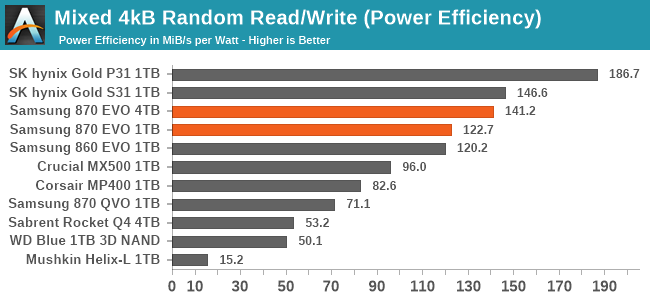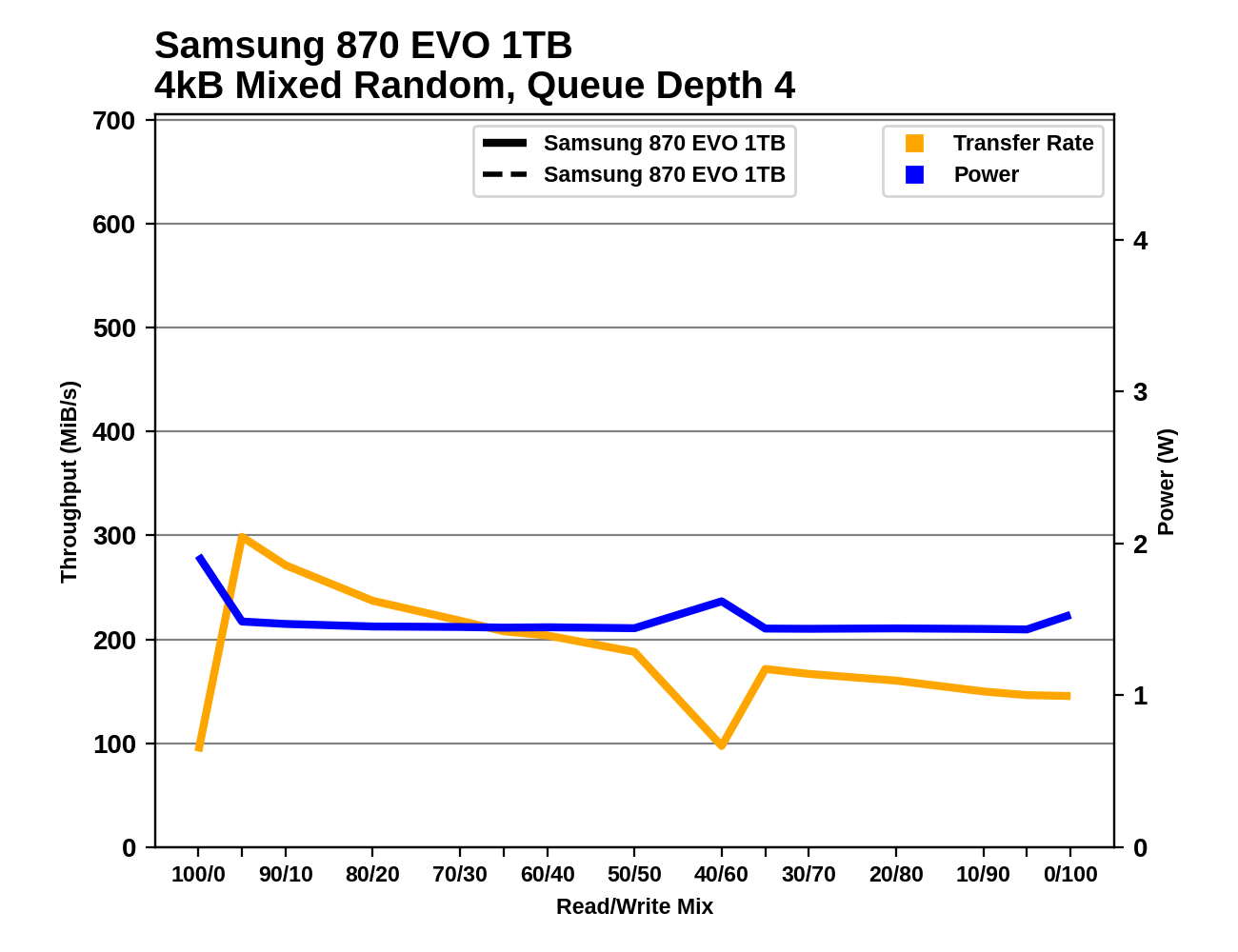The Samsung 870 EVO (1TB & 4TB) Review: Does the World Need Premium SATA SSDs?
by Billy Tallis on February 17, 2021 8:00 AM ESTMixed IO Performance
For details on our mixed IO tests, please see the overview of our 2021 Consumer SSD Benchmark Suite.
 |
|||||||||
| Mixed Random IO | Mixed Sequential IO | ||||||||
The mixed random IO test provides the Samsung 870 EVO with one of its biggest performance wins yet over the rest of the SATA field and the entry-level NVMe competition. But most of that comes from the capacity advantage the 4TB model has over most of these comparison drives; the 1TB 870 EVO is only about 5% faster overall than the 860 EVO. On the mixed sequential IO test, the SATA bottleneck keeps most of the performance scores within a fairly narrow range, and the 1TB 870 EVO's performance is actually a bit of a regression compared to its predecessor.
 |
|||||||||
| Mixed Random IO | Mixed Sequential IO | ||||||||
As with our separate tests of random reads and writes, the top efficiency scores for mixed random IO go to SK hynix, with Samsung's TLC drives turning in the next best scores and having a clear advantage over other competing brands. Over on the sequential IO side of things, the efficiency scores more closely mirror the performance scores, and the 870 EVO doesn't have any real advantage over other mainstream SATA drives.
 |
|||||||||
| Mixed Random IO | |||||||||
| Mixed Sequential IO | |||||||||
The 1TB 870 EVO's performance during the mixed random IO test is more consistent than the 860 EVO's, but still has a few unpleasant drops that aren't present for the 4TB model. On the mixed sequential IO test, the 1TB 870 EVO's performance is actually a bit less consistent than the 860 EVO. But aside from those occasional outliers, the general trend is for the 870 EVO to provide superior random IO performance and link-saturating sequential performance across a wide range of workload mixes.
Idle Power Management
Real-world client storage workloads leave SSDs idle most of the time, so the active power measurements presented earlier in this review only account for a small part of what determines a drive's suitability for battery-powered use. Especially under light use, the power efficiency of a SSD is determined mostly be how well it can save power when idle.
SATA SSDs are tested with SATA link power management disabled to measure their active idle power draw, and with it enabled for the deeper idle power consumption score and the idle wake-up latency test. Our testbed, like any ordinary desktop system, cannot trigger the deepest DevSleep idle state. For more details, please see the overview of our 2021 Consumer SSD Benchmark Suite.


The Samsung 870 EVO may feature an updated controller compared to the 860 EVO, but there's no real difference in idle power consumption, for either active idle or the desktop (non-DevSleep) idle states. Samsung's idle power figures are best in class, with SK hynix offering the only close competition.

The Samsung SATA drives all take about one millisecond to wake up from using SATA link power management. This is higher than several of the other SATA drives, but not really enough to be of much concern for system responsiveness.










136 Comments
View All Comments
Oxford Guy - Friday, February 19, 2021 - link
2TB for $200 I meant.Shlong - Thursday, February 18, 2021 - link
SATA is necessary if you need multiple drives. I only have two M.2 slots on my motherboard but numerous SATA ports. I have a 512GB boot drive and 1TB data drive in both slots. I need more storage so I have a couple 2TB SATA SSD's connected.ET - Saturday, February 20, 2021 - link
You're confusing SATA with the disk form factor. There are SATA M.2 drive, SATA 2.5" drives and SATA 3.5" drives. SATA M.2 drives get their power from the same connector, by the way.The box size has little to do with the interface, more to do with case compatibility. Cases which are built to house multiple drives have spaces set up for them. That's a standard and both cases and drives are designed for it. The drive could theoretically be designed to be smaller (and there were 1.8" drives in the past).
TelstarTOS - Wednesday, February 17, 2021 - link
More common? Yes.Cheaper? Hell no. Still over 10c/GB
Kurosaki - Wednesday, February 17, 2021 - link
A shame the 3 TB version is 379 USD to expensive. This will never work unless price per GB falls to a quarter of today's, and reliability data retention wise gets at least on par with the spinners. 479 for 4TB is just ridiculous.ksec - Wednesday, February 17, 2021 - link
SATA SSD are not intended for Speed though. They are aiming at large storage HDD replacement. Give me a QLC SATA 8TB for $399 and I will still buy it.Oxford Guy - Friday, February 19, 2021 - link
With 8TB it might not be quite so horrible.flyingpants265 - Thursday, February 18, 2021 - link
SSDs can do 3000mb/s or a lot more with parallelization and raid, you could probably get 30,000mb/s or some insane number like that, eventually with a single SSD.It's a little weird that we don't have better cables.
Great_Scott - Thursday, February 18, 2021 - link
It's interesting to see the SATA market deteriorate.I don't understand how most PCs can get away with two or one physical drive slots, but assuming that remains the trend, I wonder what NAS owners are going to do once SSDs are cheap and large enough to use for RAID but there aren't any products to use for it...
mooninite - Wednesday, February 17, 2021 - link
Why should rotating rust drives still be shipped with 512e sectors?It must be the same marketing data these manufacturers are using to show they still need to make SATA SSDs.